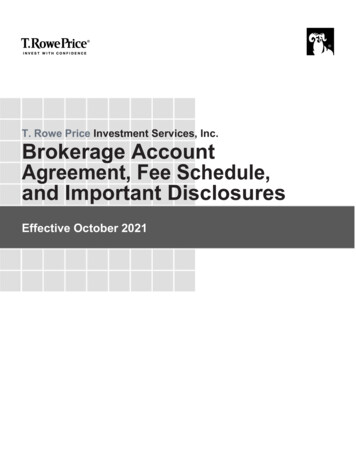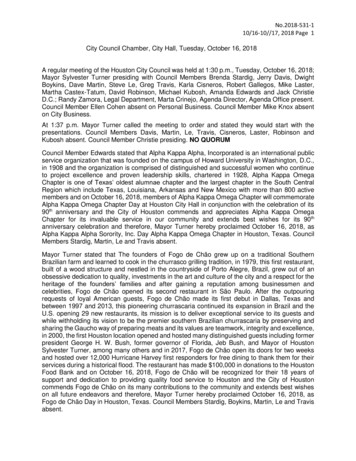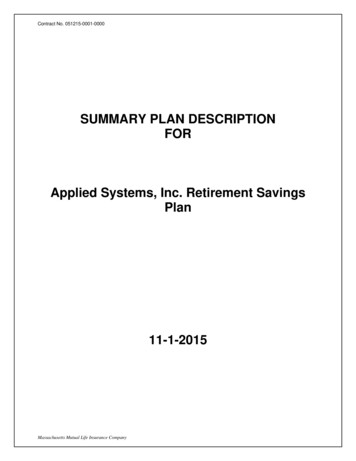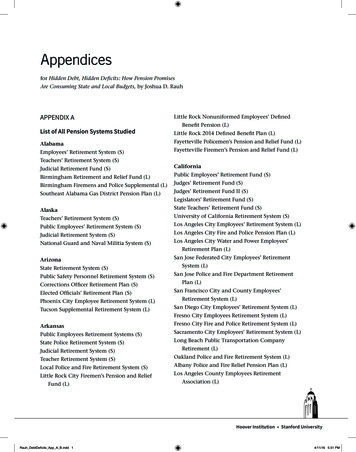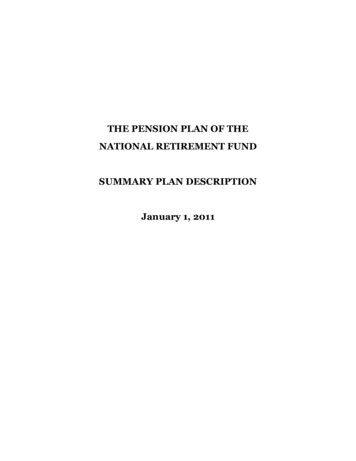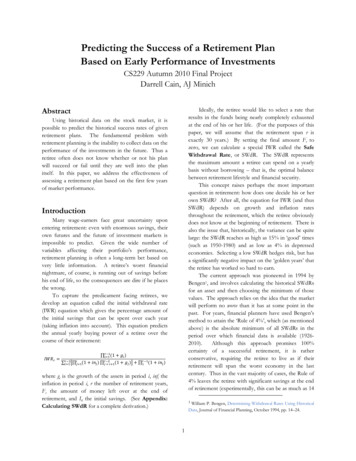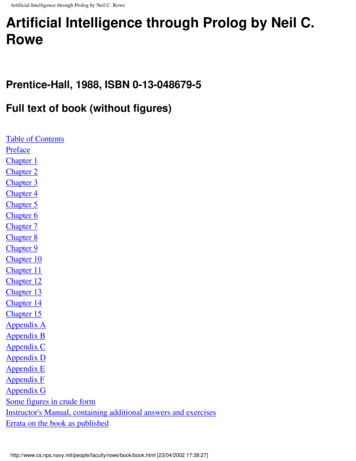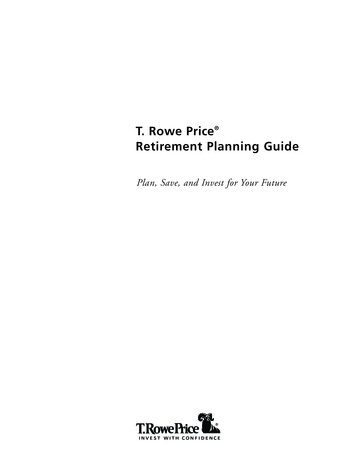
Transcription
T. Rowe Price Retirement Planning GuidePlan, Save, and Invest for Your Future
T. Rowe PriceRetirement Planning Guide4 Plan – Estimate YourIncome Needs10 Save – Decide HowMuch to Save Now16 Invest – GrowYour SavingsKit Contains T. Rowe Price MutualFunds List Learn More: Select Printand Online Resources
T. Rowe Price Retirement Planning GuideIntroductionYou don’t have to become an investment expert to plan effectively for retirement. In fact, you can develop a practical strategy by thinking about andanswering three questions: How much income might you need in retirement? How much should you save now? How should you invest to grow your savings?This guide can help you answer these questions. It’s a convenient approach toretirement planning, saving, and investing based on: More than six decades of T. Rowe Price investment research and experience The real-world insights of our financial planning experts An investment philosophy based on seeking attractive rates of return withan eye to risk. Diversification and strict attention to valuation are coreinvestment principles.Make a plan. Make it happen.You’ll retire in a newfinancial landscape, likelywithout a traditional pension. You’ll wait longerfor full Social Securitybenefits than your parents’ generation. And youmay be envisioning aretirement lifestyle nodifferent from the oneyou’re enjoying today.This all means it’s up toyou to put money awayand decide how to investit — and live with theconsequences for 30 yearsor more in retirement.The sooner you start, thebetter.It’s realistic to expect you can close this guide with a retirement savingand investing plan on paper. And — because people who have a plan savemore* — closing the guide with a plan can make a real difference in yourfuture. But only if you put your plan into action.We hope you’ll find extra motivation in the 20/20 hindsight of four retireeswhose stories we’ve included in this guide. Barb has been retired for sevenyears, Bob 10 years, David and Norine 15. They offer “been there, done that”comments about saving, investing, and the trade-offs they made along the wayto their successful retirements.†*Securities and Exchange Commission, “The Facts on Saving and Investing,” 1999.†Profiles of hypothetical investors are composites based on the experience of T. Rowe Price financial planningexperts.page 1 of 20
Profile 1BarbRetired for 7 Yearspage 2 of 20
T. Rowe Price Retirement Planning Guide“Make smart trade-offs.”“I lived large from the day I cashed my first paycheck. Great apartment. You know Iate out all the time and bought a new car every couple years. Should I mention thevacations?“So, am I living large now? You expect me to moan, ‘Oh, if only I’d saved every penny,I’d be a happy person today.’ Surprise! I am a happy person, and I haven’t had to cut wayback. That’s because when I was about 35, I was rudely awakened by my aunt’s situation.“At that time, my aunt, who’d been retired for about five years, had to sell most of herantiques, moved into a much smaller house, and cut way back on entertaining and traveling, which she loved. Turns out she simply hadn’t planned for her financial future.“I realized that if I didn’t start making some small but immediate trade-offs, I’d endup just like Aunt June, trading off my whole lifestyle later.“So I began cutting back a little here, a little more there, saved the money, and gotused to living within my means. I wasn’t willing to give up the good life when I retired,so I needed to refine my idea of what the good life really is.”page 3 of 20
Section 1Plan – Estimate Your Income Needshat will your good life in retirement cost? The answer is likely tobe found in your current lifestyle. For example, where do youlive? How do you spend your free time? Do you enjoy a largehome for family visits or entertaining? Is travel an interest? In short, what doyou use your assets for now — and what are your dreams for the future?How you answer these questions can help you anticipate your retirementincome needs. Like Barb, you may need to make trade-offs now in hopes of amore comfortable future. Or, if retirement’s several decades down the road,you may not be able to make even a rough prediction of future needs.Financial planners, who advise a broad range of people with varied retirement goals, generally suggest doing your planning assuming you’ll needat least 75% to 80% of your pretax preretirement income to maintain yourstandard of living once you’re retired. This can be an adequate estimate forlong-term planning, with the understanding that the higher your currentincome, the higher the percentage you may require later.WWhat Percent of Your Income Will You Need?These replacement percentages are for a married couple and assume that the wageearner is age 65 and has a 62-year-old spouse at retirement. The percentages aregenerally lower for single retirees (who generally have fewer expenses) and marriedcouples in which both spouses have been employed and are likely to receive more inSocial Security.Preretirement Income (In Today’sDollars) Needed in Retirement ,00078150,00085200,00088250,00088Source: Aon Consulting and the Georgia State University Center for Risk Management andInsurance Research, 2004 Retirement Income Replacement Ratio study.page 4 of 20
T. Rowe Price Retirement Planning GuideAnticipate your income sourcesToday, retirement income flows primarily from four sources: Social Securitybenefits, earned income in retirement, pensions, and personal savings. AsAmerican employment patterns change — due to increased job changing, lessopportunity to become vested in a retirement plan, and a trend among companies not to offer traditional pensions — dependence on income from eachof these sources is likely to change, too.Sources of Retirement IncomeFor those age 65 or older,highest income quintile.Concerned that you’veput off saving for retirement? You’re not alone.According to a 2002Employee BenefitsResearch Institute studyon retirement confidence,58% of workingAmericans believe they’re“a lot” or “a little”behind schedule preparing financially for thefuture.Source: Social Security Administration, Income of the Aged Chartbook, 2002.Take a realistic view of Social SecurityWill Social Security be there for you when you retire? Even though the age forfull benefits has increased, this is one government program with a high level ofboth popular and political support.While Social Security isn’t likely to disappear, the benefit you receive probably won’t provide all the retirement income you’ll need.page 5 of 20
Section 1In general, you can assume that the higher your current income, the lowerthe percentage Social Security will replace. (If you’re hoping to retire early,keep in mind that you can’t count on any benefit income from Social Securityuntil you reach age 62. If you want full benefits, you’ll need to wait until age65 or older.)To help you plan for the future, the Social Security Administrationmails you a benefit statement three months or so before your birthdayeach year. (For more information about Social Security or your benefit, call1-800-772-1213 or visit www.ssa.gov.)Social Security BenefitsBirth YearFull Benefit Age(Year Month)Age 62 Benefit(% of Full Benefit)1937 or earlier6580.0%193865 279.2193965 478.3194065 677.5194165 876.7194265 1075.81943–546675.0195566 274.2195666 473.3195766 672.5195866 871.7195966 1070.81960 and later6770.0Source: Social Security Administration, “Social Security Full Retirement and Reductions by Age.”page 6 of 20
T. Rowe Price Retirement Planning GuideWill you receive a traditional pension?A traditional pension, or defined benefit plan, usually provides a monthly payment for a number of years or for life. Generally the payment, which beginsat your normal retirement age, is based on earnings and length of employment. If you work for a company that offers this benefit, be sure you know: When you are 100% vested. That is, how long do you have to work beforeyou have a nonforfeitable right to a pension benefit at a certain age? Whether the benefit will include a cost of living increase. (Many government pensions do; most private company pensions do not.) How the benefit applies to a spouse in the event of your death.If you change jobs before retirement and you don’t roll over your vested benefit to an IRA, be sure to retain all pertinent information about your previouspension plans so you’ll have it at hand when you retire.Prepare to rely on personal savingsEven as fewer companies are offering traditional pension plans, Americanlifestyle expectations rise. In fact, the level of income needed to “satisfy aspirations” continues to increase more rapidly than household income.*In this environment, and given that many of today’s retirees already rely onpersonal savings and part-time work or self-employment for over 50% of theirincome (see chart, page 5), it’s clear that saving is key to a comfortable future.How much should you be saving now? Use the next section of the guide tofind the answer.*Employee Benefits Research Institute, 2001.page 7 of 20
Profile 2BobRetired for 10 Yearspage 8 of 20
T. Rowe Price Retirement Planning Guide“Save at least 15% now.”“I put off saving for one reason. I did a few ‘What do you need before you can retire?’quizzes, and they all gave me numbers in the hundreds of thousands of dollars.“I couldn’t even figure out how to save a penny more than I am now! I didn’t makeenough money. I had other obligations. Because I couldn’t deal with the big figure, Ididn’t deal with the future. Sure, I saved when I could. Sure, I made investments. Butsaving and investing weren’t a priority — I didn’t have a plan.“When I turned 40, I knew I needed to get serious. I started reading articles andbooks about investing. One writer suggested something like, ‘Don’t focus on the bignumber at the end. Look at smaller pieces, like how much to save each payday.’ Thismade sense to me.“I saved and made an overall investment plan. I didn’t have as much as I’d like whenI retired. But it’s 10 years since I left the world of work, and I’m OK.“Would I be better off now if I’d made a plan sooner? Definitely. Do I wish I’d savedmore so I could be living differently? Yes. Do I tell my kids to save at least 15% of theirpay no matter what? Absolutely!”page 9 of 20
Section 2Save – Decide How Much to Save Nowike Bob, many people are intimidated by the idea that they have toaccumulate hundreds of thousands of dollars for retirement. What theyhaven’t factored in is what Einstein called the eighth wonder of theworld: compounding.LLet compounding work for youConsider, for example, what happens to a 100-a-month saving over 20 years.Under the mattress, those 100 bills add up to 24,000 (20 years x 12 monthsx 100). In a tax-deferred savings account, assuming an 8% annual rate ofreturn, compounding can add more than 34,900 to the total. Instead of 24,000, you could have 58,902.*Don’t confuse what you need to accumulate with what you have to save.At the same time, don’t assume that compounding can do it all. You need toprovide the savings so compounding can work.Know what you need to save nowThe financial planners at T. Rowe Price suggest saving at least 15% of pretaxhousehold income every year. The table on page 11 provides an estimate ofhow much of your current salary you may be able to replace in retirement fromyour investments. It shows what percentage of preretirement income you maybe able to replace from savings, based on years to retirement, current savingsexpressed as a multiple of current salary, and what percentage of pretax salaryyou are saving on a tax-deferred basis each year between now and retirement.The less you’ve saved, the higher the percentage of your income you may needto consider saving now.*This example is for illustration only and is not meant to represent the performance of a particular investment.Page 10 of 20
T. Rowe Price Retirement Planning GuideFor example, if you are 30 years from retirement and have already saved three times your current salary and aresaving 15% of your salary each year, you may be able to replace 75% of your preretirement salary in retirementfrom your investments.The analysis assumes annual salary increases of 3% (no bonuses or promotions), and that the amount ofincome in retirement increases by 3% each year to keep pace with inflation. It also assumes that your portfolioconsists of 60% stocks and 40% bonds prior to retirement and 40% stocks and 60% bonds after retirement.The analysis is based on projections of 100,000 potential market scenarios for each strategy, with a 70%chance of having assets remaining at the end of a 30-year retirement period.How Much of Your Salary Can You Replace in Retirement?Projected Income as a Percent of Current Salary at RetirementAnnual Savings(% of Current Pretax Salary)0x5%10%15%20%25%7%14%20%27%34%Annual Savings(% of Current Pretax Salary)0x5%10%15%20%25%12%25%37%49%62%Annual Savings(% of Current Pretax Salary)5%10%15%20%25%0x20%40%61%81%101%20 Years to RetirementCurrent Savings as Multiple of Current Pretax Salary1x3x16%23%29%36%43%34%40%47%54%61%30 Years to RetirementCurrent Savings as Multiple of Current Pretax Salary1x3x25%37%50%62%75%50%63%75%88%100%40 Years to RetirementCurrent Savings as Multiple of Current Pretax 92%Source: T. Rowe Price Associates, Inc.Leave your savings alone!Once you’ve put money aside and invested it for retirement, resist the temptation to use it for another purpose.A “save and hold” philosophy keeps your savings working for you.If you’re tempted to dip into retirement savings, remember: You can take out a loan for a car, a home, or acollege education. But you can’t take out a loan for retirement!Page 11 of 20
Section 2Every little bit does countEven if you find 15% too high a percentage of your income to save, don’t putoff saving until you think you can afford it. What you really can’t afford in thelong run is not saving.Starting small is far better than not starting at all. Small amounts can addup. You might be surprised to learn that money you don’t spend and insteadsave pretax can make a meaningful addition to your retirement nest egg. Forinstance, if you decide not to spend 150/month in after-tax money, and saveit pretax instead, you’d be saving 200/month, assuming a 25% tax bracket.Saving Regularly Pays OffChart assumes 8% annual rate of return; for illustrative purposes only and not intended to represent any specific investment.Maximize your tax-deferred savingT. Rowe Price offers IRAs,variable annuities, and taxefficient mutual funds. Formore information, talk witha retirement specialist at1-800-638-5660.Generally, financial advisers suggest taking full advantage of tax-deferred saving opportunities before saving in after-tax accounts: First, participate in your employer’s retirement plan (a 401(k), 403(b), orSection 457, for example) if it allows you to contribute on a pretax basis.Contribute at least the percentage of your salary that your employer matches ifthere is a company match. If you can, make the maximum allowable pretaxcontribution. Remember: Your contribution reduces the amount of income youhave to pay taxes on that year. Next, take advantage of an individual retirement account (IRA). Roth IRAcontributions are never tax-deductible, but earnings may be withdrawn taxfree after age 59 1/2 if the account has been held for five years or more. Plus,you are never required to take a distribution from a Roth IRA during yourlifetime.page 12 of 20
T. Rowe Price Retirement Planning Guide If you do not qualify for a Roth IRA, considercontributing to a Traditional IRA. Even if thecontribution is not tax-deductible, you can stillget tax-deferred growth for retirement. If you can save more, consider after-tax contributions to an employer plan. Another after-tax saving option to explore isinvesting in a tax-efficient mutual fund. Can you save more? Consider a tax-deferred variable annuity. Although money contributed to anannuity is not tax-deductible, earnings grow taxdeferred. Generally, there is no annual limit on theamount you may invest in a variable annuity.If you’re self-employed.Several tax-deferred retirement plan options areavailable for self-employed individuals and smallbusiness owners. These plans include: SEP-IRA, which is easy to set up and maintain,offers immediate 100% vesting and permits, butdoes not require, annual employer contributions.Protect tax deferral when youchange jobsWhen you leave your job, what you do with themoney in an employer-sponsored retirement plancan mean you keep it tax-deferred — or lose up to40% or more to possible tax penalties and immediatetaxes. You can maintain tax deferral and avoid taxpenalties by rolling over your eligible distribution toan eligible employer retirement plan, or to an IRA.After-tax contributions, too, may be rolled over inmany instances. Learn about your options attroweprice.com/rollover or request a free RolloverIRA Guide.How should you invest the moneyyou save?The “secret” of successful retirement investing issaving regularly and following accepted investingguidelines. The last section of this guide discussesthese guidelines and how to apply them. SIMPLE IRA, which permits employee salarydeferrals, requires employer contributions, andoffers immediate 100% vesting of all contributions. Profit sharing, which offers flexibility in theamount and frequency of employer contributionsand permits a maximum vesting period of sixyears.For more information about these plans, call1-800-492-7670 or visit troweprice.com/smallbusiness.page 13 of 20
Profile 3David and NorineRetired for 15 Yearspage 14 of 20
T. Rowe Price Retirement Planning Guide“Invest to create your ‘pension.’”Norine “Talk about the odd couple! When it comes to money, we have just one thingin common: saving regularly. But while I used to be scared of stocks and put mymoney in the bank, David approached saving like a sport — chased the market,went for high returns, wanted the ‘hot’ stocks.”David“I thought we had a balanced plan. My high returns would make up forNorine’s not even keeping up with inflation. Norine’s bank account wouldprotect us if the market tanked.”Norine “We went on that way until my consulting business took off and I had to hirean accountant to do the paperwork. Anne’s the one who got us thinking aboutretirement and showed us we didn’t have a plan, let alone a balanced investmentstrategy.”Anne said, “Since you are both self-employed, you will be depending on yoursavings for most of your retirement income. You may be earning separately, butyou should be investing your savings together based on facts, not yourpersonalities.”David“Anne provided the facts. We contributed monthly to our retirement accountsand invested in a balanced portfolio based on our years to retirement. Norinestill keeps a ‘rainy day’ bank account, and I continue actively trading for fun ina smaller account — but not with our retirement money.”page 15 of 20
Section 3Invest – Grow Your Savingsou don’t have to study the stock market to be a successful long-terminvestor. In fact, as at least one study has shown, investors who payless attention to financial news in the short term may be more successful in the long term.*Even if you learn volumes about the world’s economy, the markets, and thepast performance of funds and individual investments, you can’t control theirperformance in the future.What you can control is how you allocate your retirement assets — that is,how you spread your money among stocks, bonds, and short-term investmentssuch as short-term bond funds and money market funds. And if you do thatsensibly, your long-term plan can work for you.YInvest to stay ahead of inflationYou will probably need income from your investments for a very long time, soone key goal will be for your income to increase with inflation. This is a longstudied, often-reported principle that bears repeating here because it’s so essential to long-term investing.When most investors talk about risk, they’re referring to “volatility” —short-term market ups and downs. However, over time the negative effects ofEffects of Market Volatility Diminish Over TimeSource: T. Rowe Price Associates, Inc. Chart shows best and worst average returns over eachinvestment period shown. Past performance cannot guarantee future results.*Gary Belsky and Thomas Gilovich, Why Smart People Make Big Money Mistakes and How to Correct Them,Fireside: 1999, citing a Harvard study of four sample groups of investors.page 16 of 20
T. Rowe Price Retirement Planning Guidemarket volatility have historically been reduced. The longer the time horizonto retirement, the less short-term volatility has proved to be a threat to overallinvestment success, as the chart on page 16 illustrates.Instead, it’s “inflation risk” that can really undermine the success oflong-term investors. Not investing so your returns outpace inflation robs yoursavings of buying power. That’s why putting too great a percentage of yourretirement portfolio into “safe” investments like money market funds andguaranteed investment contracts can be risky in the long term. While theseinvestments tend not to be affected by market volatility, their relatively lowreturns expose your money to more inflation risk. The chart below provides aconcrete example of how inflation can reduce purchasing power over time.Effects of Inflation Risk Increase Over TimeSource: T. Rowe Price Associates, Inc.Diversify your retirement assetsA portfolio that’s appropriately diversified among stocks, bonds, and shortterm investments works to reduce the impact of both volatility and inflationrisk. But what’s “appropriate”? What portion of your portfolio should be instock funds, for example, and in what types? How much should be in bonds?Should you keep anything in cash?page 17 of 20
Section 3As you consider possible investments, keep this inmind: The goal of asset allocation is combining different asset types that complement each other tomaximize potential return while minimizing overallportfolio volatility.Studies have shown that the combination of assetclasses you choose — rather than the specific fundsor investments you select — largely determines overall portfolio volatility and return.Decide on an investment strategyTo determine an appropriate asset allocation givenyour situation, consider your time until retirementand attitudes toward market risk. In general, forinvestors with higher tolerance for market volatility,with longer time horizons, portfolios that contain alarger allocation of stock investments may be appropriate. Investors with shorter time horizons and lesstolerance for market swings may want to include ahigher percentage of income-focused investments.In the investment planning table below, threegeneral time horizons are presented, as are threegeneral categories of market risk attitude: Higher market risk tolerance suggests a personwho is willing to invest all or part of assets instocks with the hope of increasing return potential, understanding that the risk of losing principalis also higher.T. Rowe Price Investment Strategy Planning TableLife StageAccumulationTransitionapproximately10 years todistributionDistributionHigher RiskPortfolioapproximate mixModerate RiskPortfolioapproximate mixLower RiskPortfolioapproximate mixGrowth100% EquityGrowth and Income80% Equity20% Fixed IncomeBalanced60% Equity30% Fixed Income10% Short TermGrowth and Income80% Equity20% Fixed IncomeBalanced60% Equity30% Fixed Income10% Short TermModerate Income40% Equity40% Fixed Income20% Short TermBalanced60% Equity30% Fixed Income10% Short TermModerate Income40% Equity40% Fixed Income20% Short TermIncome20% Equity50% Fixed Income30% Short TermThese allocations are determined by using standard indices that represent each category: Equity, Fixed Income, and Short Term. The categories are designed to correspond to various risk levels centered around a “balanced” portfolio (60% Equity, 30% Fixed Income, 10% ShortTerm). T. Rowe Price defines the “risk level” as the degree to which the monthly rates of return of a portfolio differ from the average rateof return of the portfolio over a specific time period (standard deviation). These illustrations use the following indices to represent the categories: Equity, S&P 500 Index; Fixed Income, U.S. Gov’t. Intermediate Index; Short Term, 30-Day Treasury Bills.Data Source: Ibbotson Associates.page 18 of 20
T. Rowe Price Retirement Planning Guide Moderate market risk tolerance suggests a person who wants to avoid takingsubstantial risk with money for important goals, yet understands the importance of investing a portion of assets in stocks for growth potential. Lower market risk tolerance suggests a person who is willing to allocate onlyConsider T. Rowe Pricea small portion of assets to stocks to help outpace inflation.Retirement FundsThis table can be a good starting point for anyone considering investments forretirement. Of course, in applying these portfolios to your own circumstances,you will want to consider your income, assets, and household investments inaddition to your retirement timetable and risk tolerance. (The portfolios areonly suggestions, and you may want to consult an adviser with regard to yourspecific situation.) Request a prospectus, which contains complete information, ora briefer profile by calling 1-800-638-2587; each includes investment objectives,risks, fees, expenses, and other information that you should read and considercarefully before investing.Use mutual funds to simplify investingInvesting in mutual funds gives you access to: Professional investment management Fund managers do the work ofselecting individual securities to achieve the fund’s objective.The T. Rowe PriceRetirement Funds offer youa single diversified portfolio that is professionallymanaged to a specificretirement fund date.These funds were createdto help you meet yourchanging financial needsup to and throughoutretirement. You simplychoose the fund with thedate that is closest to whenyou plan to retire. We’ll dothe rest.Our fund managers monitor Diversification Many funds invest no more than approximately 5% of the and adjust each fund overportfolio in any one company.time to become more Liquidity It’s easy to sell shares when you need cash. (Of course, share conservative as your retireprice reflects financial markets and may be different from the price origi- ment date approaches, andthey continue to adjustnally paid.) Services Automatic dividend reinvestment, systematic investment plans,telephone and Internet transactions, detailed account statements, andyear-end tax information are just some of the services offered with mutualfund investing.each fund for another 30years to give you a suitablebalance of growth and theincome you’ll need duringretirement.***There are many considerations when planning for retirement. Your retirementneeds, expenses, sources of income, and available assets are some important factors for you to consider in addition to the Retirement Funds. Before investingin one of these funds, also be sure to weigh your objectives, time horizon, andrisk tolerance. The funds’ investment in many underlying funds means thatthey will be exposed to the risks of different areas of the market. Investorsshould note that the higher the fund’s allocation to stocks, the greater the risk.page 19 of 20
Section 3Stick with your planWhen it comes to investing, the grass can seem greener on the other side ofthe fence, especially during market runups. Investments you don’t own postoff-the-charts performance. A new fund is all over the magazines and financialshows. Why not swap out your own boringly predictable performer?When the grass seems greener, keep in mind that long-term investingshould be about as exciting as watching a good lawn grow. True diversificationis intended to balance volatility and return potential, not chase high returns.Short-term fads, even short-term trends, have little to do with a long-terminvestment strategy. So focus on your long-term goals, not on “quick hit” highreturns.Review your plan yearlyOnce a year — or when you experience significant life changes such as marriage, divorce, or inheritance — review your retirement portfolio to be sure theasset allocation is still appropriate for you. New responsibilities may mean youwant to rethink some aspects of your investment plan. Your annual portfolioreview is a good time, too, to rebalance your portfolio and for other financialhousekeeping. Check your life, health, home, auto, and other insurance to besure they still meet your needs. Restore order to your account statements andfiles. Then, switch that savings plan on autopilot for another year.Questions? Call T. Rowe Price or visit our Web site.On the Web, over the phone, and through the mail, you’ll find T. Rowe Priceresources that can help you prepare for retirement and other aspects of yourfinancial life: Review the resource list included in this kit. Talk with a T. Rowe Price retirement specialist about services, products,and mutual fund investments appropriate for retirement investing. We areavailable at 1-800-638-5660. Get planning and investment advice from a T. Rowe Price Advisory Counselor at 1-800-831-1377. Visit troweprice.com, particularly the Retirement Accounts section. Request information using the enclosed postage-paid reply card.page 20 of 20
For fund and account informationor to conduct transactions,24 hours, 7 days a weekBy touch-tone telephoneTele*AccessSM 1-800-638-2587By Account Access on the Internettroweprice.com/accessFor assistance with your existingfund account, call:Shareholder Service Center1-800-225-5132To open a b
T. Rowe Price Retirement Planning Guide 4 Plan - Estimate Your Income Needs 10 Save - Decide How Much to Save Now 16 Invest - Grow Your Savings Kit Contains T. Rowe Price Mutual Funds List Learn More: Select Print

